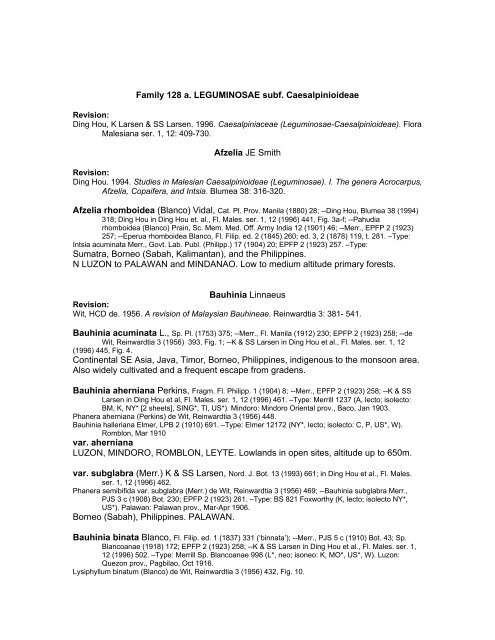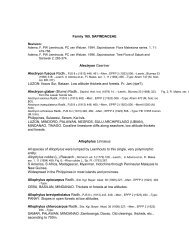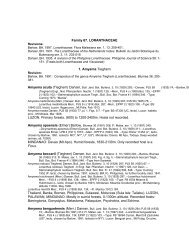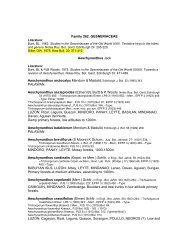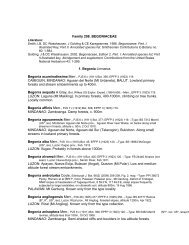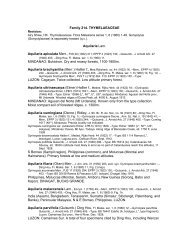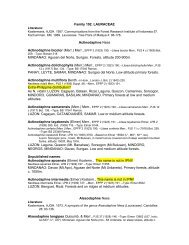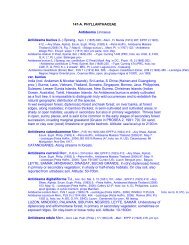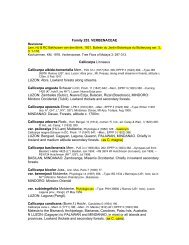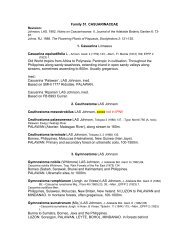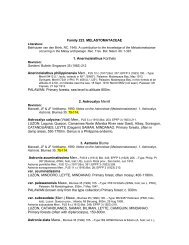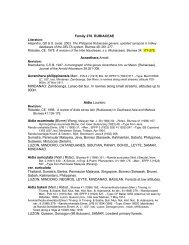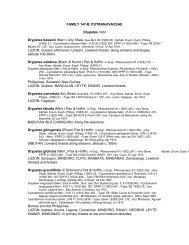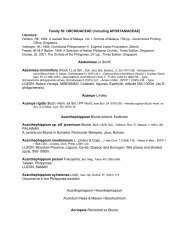Family 128 a. LEGUMINOSAE subf. Caesalpinioideae Afzelia JE ...
Family 128 a. LEGUMINOSAE subf. Caesalpinioideae Afzelia JE ...
Family 128 a. LEGUMINOSAE subf. Caesalpinioideae Afzelia JE ...
You also want an ePaper? Increase the reach of your titles
YUMPU automatically turns print PDFs into web optimized ePapers that Google loves.
<strong>Family</strong> <strong>128</strong> a. <strong>LEGUMINOSAE</strong> <strong>subf</strong>. <strong>Caesalpinioideae</strong><br />
Revision:<br />
Ding Hou, K Larsen & SS Larsen. 1996. Caesalpiniaceae (Leguminosae-<strong>Caesalpinioideae</strong>). Flora<br />
Malesiana ser. 1, 12: 409-730.<br />
<strong>Afzelia</strong> <strong>JE</strong> Smith<br />
Revision:<br />
Ding Hou. 1994. Studies in Malesian <strong>Caesalpinioideae</strong> (Leguminosae). I. The genera Acrocarpus,<br />
<strong>Afzelia</strong>, Copaifera, and Intsia. Blumea 38: 316-320.<br />
<strong>Afzelia</strong> rhomboidea (Blanco) Vidal, Cat. Pl. Prov. Manila (1880) 28; --Ding Hou, Blumea 38 (1994)<br />
318; Ding Hou in Ding Hou et. al., Fl. Males. ser. 1, 12 (1996) 441, Fig. 3a-f; --Pahudia<br />
rhomboidea (Blanco) Prain, Sc. Mem. Med. Off. Army India 12 (1901) 46; --Merr., EPFP 2 (1923)<br />
257; --Eperua rhomboidea Blanco, Fl. Filip. ed. 2 (1845) 260; ed. 3, 2 (1878) 119, t. 281. –Type:<br />
Intsia acuminata Merr., Govt. Lab. Publ. (Philipp.) 17 (1904) 20; EPFP 2 (1923) 257. –Type:<br />
Sumatra, Borneo (Sabah, Kalimantan), and the Philippines.<br />
N LUZON to PALAWAN and MINDANAO. Low to medium altitude primary forests.<br />
Bauhinia Linnaeus<br />
Revision:<br />
Wit, HCD de. 1956. A revision of Malaysian Bauhineae. Reinwardtia 3: 381- 541.<br />
Bauhinia acuminata L., Sp. Pl. (1753) 375; --Merr., Fl. Manila (1912) 230; EPFP 2 (1923) 258; --de<br />
Wit, Reinwardtia 3 (1956) 393, Fig. 1; --K & SS Larsen in Ding Hou et al., Fl. Males. ser. 1, 12<br />
(1996) 445, Fig. 4.<br />
Continental SE Asia, Java, Timor, Borneo, Philippines, indigenous to the monsoon area.<br />
Also widely cultivated and a frequent escape from gradens.<br />
Bauhinia aherniana Perkins, Fragm. Fl. Philipp. 1 (1904) 8; --Merr., EPFP 2 (1923) 258; --K & SS<br />
Larsen in Ding Hou et al, Fl. Males. ser. 1, 12 (1996) 461. –Type: Merrill 1237 (A, lecto; isolecto:<br />
BM, K, NY* [2 sheets], SING*, TI, US*). Mindoro: Mindoro Oriental prov., Baco, Jan 1903.<br />
Phanera aherniana (Perkins) de Wit, Reinwardtia 3 (1956) 448.<br />
Bauhinia halleriana Elmer, LPB 2 (1910) 691. –Type: Elmer 12172 (NY*, lecto; isolecto: C, P, US*, W).<br />
Romblon, Mar 1910<br />
var. aherniana<br />
LUZON, MINDORO, ROMBLON, LEYTE. Lowlands in open sites, altitude up to 650m.<br />
var. subglabra (Merr.) K & SS Larsen, Nord. J. Bot. 13 (1993) 661; in Ding Hou et al., Fl. Males.<br />
ser. 1, 12 (1996) 462.<br />
Phanera semibifida var. subglabra (Merr.) de Wit, Reinwardtia 3 (1956) 469; --Bauhinia subglabra Merr.,<br />
PJS 3 c (1908) Bot. 230; EPFP 2 (1923) 261. –Type: BS 821 Foxworthy (K, lecto; isolecto NY*,<br />
US*). Palawan: Palawan prov., Mar-Apr 1906.<br />
Borneo (Sabah), Philippines. PALAWAN.<br />
Bauhinia binata Blanco, Fl. Filip. ed. 1 (1837) 331 (‘binnata’); --Merr., PJS 5 c (1910) Bot. 43; Sp.<br />
Blancoanae (1918) 172; EPFP 2 (1923) 258; --K & SS Larsen in Ding Hou et al., Fl. Males. ser. 1,<br />
12 (1996) 502. –Type: Merrill Sp. Blancoanae 998 (L*, neo; isoneo: K, MO*, US*, W). Luzon:<br />
Quezon prov., Pagbilao, Oct 1916.<br />
Lysiphyllum binatum (Blanco) de Wit, Reinwardtia 3 (1956) 432, Fig. 10.
Bauhinia blancoi (Benth.) Baker in Hook.f., Fl. Brit. India 2 (1878) 278; --Perkins, Fragm. Fl. Philip. 1 (1904)<br />
8; --Phanera blancoi Benth. In Miq., Pl. Jungh. (1852) 264. –Type: Cuming 1518 (E, PRC, W).<br />
Thailand, throughout Malesia (excepting Sumatra and Malay Peninsula) to N Australia.<br />
LUZON: Zambales, Quezon, CORON, PALAWAN, DUMARAN, PANAY, NEGROS,<br />
CEBU, BOHOL, SIBUTU, BASILAN, MINDANAO. Restricted to coastal areas, in sandy<br />
soil as well as among rocks and in tidal forests. Prefential to seasonal areas.<br />
Bauhinia dolichocalyx Merr., PJS 3 c (1908) Bot. 231; EPFP 2 (1923) 259; --K & SS Larsen in Ding<br />
Hou et al., Fl. Males. ser. 1, 12 (1996) 448. –Type: FB 7756 Curran & Merritt (PNH, holo, lost; US*,<br />
lecto, here designated). Luzon: Batangas prov., 28 Oct 1907.<br />
Gigasiphon dolichocalyx (Merr.) de Wit, Reinwardtia 3 (1956) 420, Fig. 6.<br />
Bauhinia grandiflora Blanco, Fl. Filip. (1837) 332; ed. 2, 1 (1845) 231; ed. 3, 2 (1878) 67, non Juss. –Type:<br />
non extant; Neotype, here designated: Merrill Sp. Blancoanae 531, leg. M Ramos (US*, neo; NY*,<br />
isoneo). Luzon: Batangas prov., Mt San Pedro, slopes, dry forest, altitude 55m, 20 Aug 1914.<br />
LUZON: Batangas. Dry slopes at low altitudes. Known only from the type locality and<br />
vicinity.<br />
Bauhinia finlaysoniana (Grah. ex Benth. ) Baker in Hook.f., Fl. Brit. Ind. 2 (1878) 278.<br />
var. leptopus (Perkins) K & SS Larsen, Nord. J. Bot. 13 (1993) 663; --K & SS Larsen in Ding Hou<br />
et al., Fl. Males. ser. 1, 12 (1996) 514; --Phanera finlaysoniana Grah. ex Benth. var. leptopus<br />
(Perkins) de Wit, Reinwardtia 3 (1956) 509; --Bauhinia leptopus Perkins, Fragm. Fl. Philipp. 1<br />
(1904) 10; --Merr., PJS 5 c (1910) Bot. 44; EPFP 2 (1923) 259. –Type: Warburg <strong>128</strong>24 (E, lecto).<br />
Luzon: Quezon prov.<br />
Sumatra, Java, Borneo, Philippines, Moluccas. LUZON: Quezon, Camarines, PANAY,<br />
NEGROS, LEYTE, SAMAR, MINDANAO: Lanao del Sur, Davao. Low and medium<br />
altitude forests.<br />
Bauhinia integrifolia Roxb., Hort. Beng. (1814) 90, nom. nud., Fl. Ind., ed. Carey, 2 (1832) 331; --K<br />
& SS Larsen in Ding Hou et al., Fl. Males. ser. 1, 12 (1996) 480.<br />
Phanera integrifolia (Roxb.) Benth. in Miq., Pl. Jungh. (1852) 263; --de Wit, Reinwardtia 3 (1956) 478.<br />
ssp. cumingiana (Benth.) K & SS Larsen, Nord. J. Bot. 2 (1982) 332; ibid. 13 (1993) 658; --K &<br />
SS Larsen in Ding Hou et al., Fl. Males. ser. 1, 12 (1996) 481; --Bauhinia cumingiana (Benth.)<br />
Fern.-Villar, Novis. App. (1880) 73; --Phanera integrifolia (Roxb.) Benth. ssp. cumingiana (Benth.)<br />
de Wit, Reinwardtia 3 (1956) 480, Fig. 19; --Phanera cumingiana Benth. In Miq., Pl. Jungh. (1852)<br />
263. –Type: Cuming 1785 (K, lecto; isolecto: E, G, L*, OXF, P, PRC, W).<br />
var. cumingiana<br />
Borneo (Sabah), Philippines. N LUZON (Cagayan) to MINDANAO. Low and medium<br />
altitude forests.<br />
var. nymphaefolia (Perkins) K & SS Larsen, Nord. J. Bot. 13 (1993) 658; --K & SS Larsen in Ding<br />
Hou et al., Fl. Males. ser. 1, 12 (1996) 482. –Type:<br />
Phanera integrifolia (Roxb.) Benth. ssp. cumingiana (Benth.) de Wit var. nymphaefolia (Perkins) de Wit,<br />
Reinwardtia 3 (1956) 482; --Bauhinia nymphaefolia Perkins, Fragm. Fl. Philip. 1 (1904) 11.<br />
Bauhinia whitfordii Elmer, LPB 1 (1907) 229; --Merr., PJS 5 c (1910) Bot. 44; EPFP 2 (1923) 261. –Type:<br />
Elmer 8897 (NY*, US*, iso). Luzon: Benguet prov., Baguio, Mar 1907.<br />
LUZON: Benguet, Cagayan, Zambales, Bataan. Lowland to medium altitude thickets and<br />
forests.<br />
Bauhinia lingua DC, Prodr. 2 (1825) 516; --K & SS Larsen in Ding Hou et al., Fl. Males. ser. 1, 12<br />
(1996) 483.<br />
Bauhinia warburgii Perkins, Fragm. Fl. Philip. 1 (1904) 12; --Merr., PJS 5 c (1910) Bot. 46; EPFP 2 (1923)<br />
261. –Type: Warburg <strong>128</strong>23 (not seen).<br />
Bauhinia pinchotiana Perkins, Fragm. Fl. Philip. 1 (1904) 12; --Merr., PJS 5 c (1910) Bot. 45. –Type: Cuming<br />
1119 (K, lecto; isolecto: E, G, L* [2 sheets], P, W). Luzon: Ilocos Sur prov.<br />
Bauhinia semibifida auct. non Roxb.: Vidal, Sinopsis Atlas (1883) 24, pl. 43, Fig. 1; --Fern-Villar, Novis. App.<br />
(1880) 73.
var. lingua<br />
Lesser Sunda Isls, Philippines, Sulawesi, New Guinea. LUZON: Ilocos Sur, Apayao,<br />
Quezon, Camarines, LEYTE, SAMAR. Low altitude forests.<br />
var. antipolana (Perkins) K & SS Larsen, Nord. J. Bot. 13 (1993) 660; --K & SS Larsen in Ding<br />
Hou et al., Fl. Males. ser. 1, 12 (1996) 485; --Bauhinia antipolana Perkins, Fragm. Fl. Philip. 1<br />
(1904) 9; --Merr., PJS 5 c (1910) Bot. 45. –Type: Merrill 1317 (NY). Luzon: Rizal prov., Antipolo,<br />
Feb 1903.<br />
Bauhinia chalcobapta Quisumb. & Merr., PJS 37 (1928) 151. –Type: BS 47217 Ramos & Edaño (NY*, US*<br />
iso). Luzon: Isabela prov., San Mariano, along stream in open forests, altitude c. 650m, 26 Mar<br />
1926.<br />
LUZON: Isabela, Rizal. Open forests, altitude c. 650m.<br />
Bauhinia malabarica Roxb., Hort. Beng. (1814) 31, nom. nud., Fl. Ind., ed. Carey, 2 (1832) 321; --<br />
Merr., EPFP 2 (1923) 260; --K & SS Larsen in Ding Hou et al., Fl. Males. ser. 1, 12 (1996) 456.<br />
Piliostigma malabaricum (Roxb.) Benth. var. acidum de Wit, Reinwardtia 3 (1956) 531, Fig. 30.<br />
India, Myanmar, Thailand, Cambodia, Laos and Vietnam, Java to Timor, the Philippines,<br />
Australia (Queensland). A typical species of the more seasonal parts of the archipelago.<br />
Bauhinia merrilliana Perkins, Fragm. Fl. Philipp. 1 (1904) 10; --Merr., PJS 5 c (1910) Bot. 45; EPFP<br />
2 (1923) 260; --K & SS Larsen in Ding Hou et al., Fl. Males. ser. 1, 12 (1996) 485, Fig. 10a. –Type:<br />
Merrill 694 (A, holo; iso: BM, NY*, SING, US*). Palawan: Palawan prov., I-wi-ig (=Iwahig) River, 18<br />
Feb 1903.<br />
Phanera merrilliana (Perkins) de Wit, Reinwardtia 3 (1956) 461.<br />
var. merrilliana<br />
PALAWAN, MINDANAO: Zamboanga. Lowland thickets and forests.<br />
Bauhinia monandra Kurz, J. As. Soc. Beng. 42, ii (1873) 73; --Merr., EPFP 2 (1923) 260; --de Wit,<br />
Reinwardtia 3 (1956) 401; --K & SS Larsen in Ding Hou et al., Fl. Males. ser. 1, 12 (1996) 450. –<br />
Type from Myanmar.<br />
Origin unknown, only known in the cultivated state. Closest relatives from South America<br />
and hence may be neotropic. Widely cultivated in the tropics on account of its showy<br />
flowers. In Malesia grown all over, but not commonly.<br />
Bauhinia pachyphylla Merr., PJS 27 (1925) 25; EPFP 4 (1925) 252; --K & SS Larsen in Ding Hou et<br />
al., Fl. Males. ser. 1, 12 (1996) 487. --Type: Loher 12978 (K, lecto; isolecto: M). Luzon: Rizal prov.,<br />
Balintingan, altitude c. 1400m, Apr 1915.<br />
Phanera pachyphylla (Merr.) de Wit, Reinwardtia 3 (1956) 461.<br />
var. pachyphylla<br />
LUZON: Rizal. Known only with certainty from the type collection. A collection from<br />
Aurora prov. (Baler), according to Larsen has floral characters agreeing with this species<br />
but with different leaves.<br />
var. wenzelii K & SS Larsen, Nord. J. Bot. 13 (1993) 659; --K & SS Larsen in Ding Hou et al., Fl.<br />
Males. ser. 1, 12 (1996) 488. –Type: Wenzel 2537 (NY*, holo; iso: BO, BR, K, MO, PR). Mindanao:<br />
Surigao del Norte prov., 20 Apr 1927.<br />
MINDANAO: Surigao del Norte.<br />
Bauhinia pauciflora Merr., PJS 10 c (1915) Bot. 13; EPFP 2 (1923) 260; --K & SS Larsen in Ding<br />
Hou et al., Fl. Males. ser. 1, 12 (1996) 488. –Type: BS 13113 Foxworthy & Ramos (K, lecto;<br />
isolecto: L*, US*). Luzon: Quezon prov., Dapdap Point, in forest, Mar 1911.<br />
Phanera pauciflora (Merr.) de Wit, Reinwardtia 3 (1956) 462.<br />
LUZON: Quezon. Lowland forest. Known only with certainty from the type. De Wit (1956)<br />
and Larsen (1996) cite several collections from Mountain Province (actually Ifugao),<br />
Zambales, Rizal, and Quezon as probably conspecific with this species.
Bauhinia purpurea L., Sp. Pl. (1753) 375; --Merr., EPFP 2 (1923) 261; --de Wit, Reinwardtia 3 (1956)<br />
406; --K & SS Larsen in Ding Hou et al., Fl. Males. ser. 1, 12 (1996) 452. –Neotype: Merrill Sp.<br />
Blancoanae 1050 (L, designated by de Wit, 1956; isoneo: US*).<br />
Native of tropical Asia, probably only in the continental monsoon area NW to Nepal.<br />
Cultivated throughout S and SE Asia.<br />
Bauhinia semibifida Roxb., Hort. Beng. (1814) 31, nom. nud.; Fl. Ind., ed. Carey, 2 (1832) 330; --K &<br />
SS Larsen in Ding Hou et al., Fl. Males. ser. 1, 12 (1996) 490, Fig. 11a, b.<br />
Phanera semibifida (Roxb.) .) Benth. in Miq., Pl. Jungh. (1852) 263; --de Wit, Reinwardtia 3 (1956) 465, Fig.<br />
15.<br />
var. semibifida<br />
Sumatra, Peninsular Malaysia, Borneo, Philippines, Sulawesi. Forest margins.<br />
var. perkinsae (Merr.) K & SS Larsen, Nord. J. Bot. 13 (1993) 661; --K & SS Larsen in Ding Hou et<br />
al., Fl. Males. ser. 1, 12 (1996) 494.<br />
Bauhinia perkinsae Merr., Govt. Lab. Publ. (Philip.) 17 (1904) 2; --EPFP 2 (1923) 260, as ‘perkinsiae’. –<br />
Type: Merrill 731 (NY, lecto; isolecto: K, US*). Palawan: Palawan prov., I-wi-ig [=Iwahig] River, 18<br />
Feb 1903.<br />
PALAWAN. Lowland thickets.<br />
Bauhinia tomentosa L., Sp. Pl. (1753) 375; --Merr., EPFP 2 (1923) 261; --de Wit, Reinwardtia 3<br />
(1956) 409; --K & SS Larsen in Ding Hou et al., Fl. Males. ser. 1, 12 (1996) 454.<br />
Origin in tropical Asia, probably spontaneous in India. Cultivated in the Philippines,<br />
sometimes escaping.<br />
Bauhinia variegata L., Sp. Pl. (1753) 375; --de Wit, Reinwardtia 3 (1956) 411; --K & SS Larsen in Ding<br />
Hou et al., Fl. Males. ser. 1, 12 (1996) 454.<br />
Indigenous to S China, Myanmar, N Thailand, Laos and Vietnam. Widely cultivated in<br />
the tropics, also in Malesia.<br />
Caesalpinia Linnaeus<br />
Revision:<br />
Hattink, TA. 1974. A revision of Malesian Caesalpinia, including Mezoneuron (Leguminosae-<br />
Caesalpiniaceae). Reinwardtia 9: 1-69.<br />
Caesalpinia bonduc (L.) Roxb., Fl. Ind., ed. Carey 2 (1832) 362; emend. Dandy & Exell, J. Bot. 76<br />
(1938) 179; --Hattink, Reinwardtia 9 (1974) 17, Fig. 3; --Ding Hou in Ding Hou et al., Fl. Males. ser.<br />
1, 12 (1996) 541.<br />
Pantropic. All over Malesia but distinctly scarce in the rainforest areas in Sumatra,<br />
Borneo, the Philippines and W New Guinea. Often in thickets along or near the<br />
seashore.<br />
Caesalpinia crista L., Sp. Pl. (1753) 380, pro parte; --Merr., Fl. Manila (1912) 232; EPFP 2 (1923) 266<br />
(excluding syn. Guilandina bonduc L., G. bonducella L. & Caesalpinia bonducella Flem.); --Hattink,<br />
Reinwardtia 9 (1974) 20, Fig. 4/3; --Ding Hou in Ding Hou et al., Fl. Males. ser. 1, 12 (1996) 542. –<br />
Type from Sri Lanka.<br />
Caesalpinia nuga (L.) Aiton, Hort. Kew., ed. 2, 3 (1811) 32; --Merr., PJS 5 c (1910) Bot. 54; Fl. Manila (1912)<br />
232; EPFP 2 (1923) 267; --Guilandina nuga L., Sp. Pl. ed. 2 (1762) 546. –Type from Ambon.<br />
Caesalpinia laevigata Perr., Mém. Soc. Linn. Paris 3 (1824) 104. –Type: Perrottet sn., Philippines.<br />
Coastal parts of SE Asia, from India through Malesia to Ryukyu Isls, Australia<br />
(Queensland), Palau Is & New Caledonia. All over Malesia except E Sumatra and E<br />
Borneo. Throughout the Philippines. Coastal thickets, tidal swamps, sandy beaches, in
and behind the sandy parts of mangroves, etc.<br />
Caesalpinia cucullata Roxb., [Hort. Beng. (1814) 32, nom. nud.] Fl. Ind., ed. Carey 2 (1832) 358; --<br />
Hattink, Reinwardtia 9 (1974) 22--Ding Hou in Ding Hou et al., Fl. Males. ser. 1, 12 (1996) 543.<br />
Mezoneuron cucullatum (Roxb.) Wight & Arn., Prodr. (1834) 283; --Merr., EPFP 2 (1923) 268.<br />
India, China, Vietnam, Thailand, N & W Sumatra, Peninsular Malaysia, Java, Lesser<br />
Sunda Isls (Bali), Borneo (Kalimantan: Banjarmasin), Philippines.<br />
LUZON: Laguna, MINDANAO: Lanao del Sur. Medium altitude forests along streams<br />
and lakes.<br />
Caesalpinia decapetala (Roth) Alston, Fl. Ceylon, Suppl. (1931) 89; -- Hattink, Reinwardtia 9<br />
(1974) 24; --Ding Hou in Ding Hou et al., Fl. Males. ser. 1, 12 (1996) 543; Reichardia? decapetala<br />
Roth, Nov. Pl. Sp. (1821) 212. –Type from India.<br />
Caesalpinia sepiaria Roxb. [Hort. Beng. (1814) 32, nom. nud.], Fl. Ind. ed. Carey, 2 (1832) 360; --Merr., PJS<br />
5 c (1910) Bot. 55, 371; EPFP 2 (1923) 268. –Type from India.<br />
Mezoneuron benguetense (Elmer) Elmer, LPB 1 (1907) 362; --Caesalpinia benguetensis Elmer, LPB 1<br />
(1907) 226. –Type: Elmer 8720 (BO, K*, L*, US*, iso). Luzon: Benguet prov., Baguio, Mar 1907<br />
India, Sri Lanka, Myanmar, China, Japan, Sumatra (N half), Peninsular Malaysia<br />
(Penang Is), Java, Lesser Sunda Isls (Lombok; Flores; Timor), N Philippines, SW<br />
Sulawesi, Pacific islands (Tahiti; Oahu, indigenous?).<br />
LUZON: Isabela, Benguet. Also cultivated in other tropical countries and then run wild.<br />
Thickets about limestone cliffs and boulders, altitude c. 1200m.<br />
Caesalpinia latisiliqua (Cav.) Hattink, Reinwardtia 9 (1973) 37; --Ding Hou in Ding Hou et al., Fl.<br />
Males. ser. 1, 12 (1996) 547; --Mezoneuron latisiliquum (Cav.) Merr., PJS 4 c (1909) Bot. 268;<br />
EPFP 2 (1923) 268; --Bauhinia? latisiliqua Cav., Ic. 5 (1799) 5, t. 408. –Type: Cavanilles’ plate<br />
excl.<br />
bauhinioid leaves, from Luzon.<br />
Caesalapinia torquata Blanco, Fl. Filip. (1837) 336. –Type: lost.<br />
Mezoneurum glabrum auct. non Desf.: Fern.-Villar, Novis. App. (1880) 70.<br />
Mezoneurum rubrum Merr., Govt. Lab. Publ. (Philip.) 6 (1904) 7. –Type: Merrill 805 (PNH, holo, lost; iso: K*,<br />
US*). Palawan: Palawan prov., Point Separacion, 20 Feb 1903.<br />
Mezoneurum cabadbarense Elmer, LPB 10 (1939) 3757. --Type: Elmer 13386 (BM, BO, GH, K*, L*, NY*, P,<br />
PNH, U*, iso). Mindanao: Agusan del Norte prov., Cabadbaran, Mt Urdaneta [=Mt Hilong-hilong],<br />
Jul 1912.<br />
Mezoneuron sumatranum Merr., EPFP 2 (1923) 269, non (Roxb.) Wight & Arn. (1834).<br />
Vietnam, Borneo (Sarawak, Brunei, Kalimatan), Philippines (widespread), Sulawesi (N,<br />
C & SE), Papua New Guinea (Morobe). Rocks on sunny hot dry slopes, riverbanks and<br />
roadsides, secondary forest fringes and thickets, altitude 50-1500m.<br />
Caesalpinia mindorensis (Merr.) Hattink, Reinwardtia 9 (1973) 41; --Ding Hou in Ding Hou et al.,<br />
Fl. Males. ser. 1, 12 (1996) 548; --Mezoneuron mindorense Merr., PJS 3 c (1908) Bot. 232; EPFP<br />
2<br />
(1923) 268. –Type: FB 5383 Merritt (not seen). Mindoro: Mindoro Oriental prov., Pinamalayan, in<br />
thickets near sea level, Oct 1906.<br />
Mezoneuron mindorense Merr. var. inermis Merr., PJS 3 c (1908) Bot. 232; EPFP 2 (1923) 268. –Type: BS<br />
1514 J Bermejos (iso: BO, GH, K*, NY*, US*). Mindoro: Mindoro Oriental prov., Bulalacao, 30 Aug<br />
1906.<br />
MINDORO, BILIRAN, MINDANAO. Lowland secondary forests, edge of swamps,<br />
thickets.<br />
Caesalpinia parviflora Prain, J. As. Soc. Beng. 66, ii (1897) 230 (descr.), 470, inc. var. typica; --<br />
Hattink, Reinwardtia 9 (1974) 45; --Ding Hou in Ding Hou et al., Fl. Males. ser. 1, 12 (1996) 549. –<br />
Type from Peninsular Malaysia.<br />
Caesalpinia minutiflora Elmer, LPB 5 (1913) 1803. –Type: Elmer 12969 (iso: BM, K, L*, NY*, P, PNH, U*,<br />
US*). Palawan: Palawan prov., Puerto Princesa, Mt Pulgar [=Thumb Peak], ‘over riverbank woods<br />
at 250ft in red stony soil’, Apr 1911.
Peninsular Malaysia, Borneo, Philippines.<br />
PALAWAN. Lowland forests and clearings.<br />
Caesalpinia pubescens (Desf.) Hattink, Reinwardtia 9 (1973) 47; --Ding Hou in Ding Hou et al.,<br />
Fl. Males. ser. 1, 12 (1996) 550; --Mezoneuron pubescens Desf., Mém. Mus. Paris 4 (1818) 245; --<br />
Merr., PJS 5 c (1910) Bot. 56; Fl. Manila (1912) 230; Sp. Blancoanae (1918) 176; EPFP 2 (1923)<br />
269. –Type from Java.<br />
N Vietnam, Peninsular Thailand, Bangka, Java, Madura, Kangean Isls, Lesser Sunda<br />
Isls (Bali; Lombok; Sumbawa; Flores; Timor; Wetar), N Philippines, Sulawesi (SW and<br />
Salajar).<br />
LUZON: Pangasinan, Pampanga, Bulacan, Rizal. Lowlands in open dry grasslands, thin<br />
thickets, etc. Prefers seasonal drought and flowers at the end of the wet season.<br />
Caesalpinia pulcherrima (L.) Sw., Obs. Bot. (1791) 66; --Hattink, Reinwardtia 9 (1974) 50; --Ding<br />
Hou in Ding Hou et al., Fl. Males. ser. 1, 12 (1996) 551; --Poinciana pulcherrima L., Sp. Pl. (1753) 380.<br />
Syntypes from India.<br />
Native of tropical America, now distributed pantropically. Cultivated as an ornamental<br />
throughout the Philippines, naturalized in some regions.<br />
Caesalpinia sappan L., Sp. Pl. (1753) 381; -- Hattink, Reinwardtia 9 (1974) 51; --Ding Hou in Ding<br />
Hou et al., Fl. Males. ser. 1, 12 (1996) 551. –Type from Sri Lanka.<br />
Origin unknown. Cultivated in S & SE Asia, Malesia, Africa and America. Sometimes<br />
escaped from cultivation. Throughout the Philippines at low and medium altitudes. In dry<br />
thickets, parang, etc., locally abundant.<br />
Cassia Linnaeus<br />
Revision:<br />
Wit, HCD de. 1955. A revision of the genus Cassia (Caesalp.) as occurring in Malaysia. Webbia<br />
11: 197-292.<br />
Cassia fistula L., Sp. Pl. (1753) 377; de Wit, Webbia 11 (1956) 207; Blanco, Fl. Filip. (1837) 339; ed.<br />
2 (1845) 237; ed. 3, 2 (1878) 77; t. 124 bis; --Vidal, Rev. Pl. Vasc. Filip. (1886) 116; --Perkins, Fragm. Fl.<br />
Philip. (1904) 14; --Merr., PJS 1 (1906) Suppl. 63; ibid. 3 c (1908) Bot. 82; ibid. 5 c (1910) Bot. 50; Fl. Manila<br />
(1912) 234; Sp. Blancoanae (1918) 174; EPFP 2 (1923) 262; --K Larsen & Ding Hou in Ding Hou et al., Fl.<br />
Males. ser. 1, 12 (1996) 557, Fig. 21<br />
Probably native of India and Sri Lanka and perhaps in Myanmar and N Thailand, now<br />
widespread in the tropics, also in the Neotropics. Most certainly introduced to China,<br />
Peninsular Malaysia and the Philippines.<br />
Cassia grandis L.f., Suppl. (1781) 230; --K Larsen & Ding Hou in Ding Hou et al., Fl. Males. ser. 1, 12<br />
(1996) 559; --Soejarto et al. (1995) Checklist Fl. Pl. Palawan.<br />
Native of tropical America. Introduced as an ornamental all over the tropics. PALAWAN<br />
(Aborlan; Puerto Princesa)<br />
Cassia javanica L., Sp. Pl. (1753) 378; --Fern.-Villar, Novis. App. (1880) 70; --Vidal, Sinopsis Atlas<br />
(1883) 24, t. 42, Fig. D; Rev. Pl. Vasc. Filip. (1886) 116; --Perkins, Fragm. Fl. Philip. (1904) 14; --<br />
Merr., PJS 1 (1906) Suppl. 63; ibid. 3 c (1908) Bot. 82; ibid. 5 c (1910) Bot. 48; Sp. Blancoanae<br />
(1918) 174; EPFP 2 (1923) 263; --K Larsen & Ding Hou in Ding Hou et al., Fl. Males. ser. 1, 12<br />
(1996) 561, Fig. 22.<br />
ssp. javanica<br />
Widespread in Malesia, wild and cultivated. Now widely cultivated all over tropical Asia.<br />
Introduced and planted in the more seasonal parts of the Philippines, low altitudes.
ssp. nodosa (Buch.-Ham. ex Roxb.) K & SS Larsen, Nat. Hist. Bull. Siam. Soc. 25 (1974) 205;<br />
--K Larsen & Ding Hou in Ding Hou et al., Fl. Males. ser. 1, 12 (1996) 564; --Cassia nodosa Buch.-<br />
Ham. ex Roxb., Fl. Ind. ed. Carey, 2 (1832) 336.<br />
S Thailand through Peninsular Malaysia to Java and the Lesser Sunda Isls. Also widely<br />
cultivated in the Neotropics. Introduced and planted in the more seasonal parts of the<br />
Philippines, low altitudes.<br />
ssp. pubifolia (Merr.) K Larsen, Nord. J. Bot. 13 (1993) 403; --K Larsen & Ding Hou in Ding Hou et<br />
al., Fl. Males. ser. 1, 12 (1996) 564, (as ‘pubiflora’); --Cassia javanica var. pubifolia Merr., PJS 5 c<br />
(1910) Bot. 48; EPFP 2 (1923) 263; -- –Type: Decades Philip. Forest Fl. No. 37, leg. Ahern’s<br />
collector (NY, lecto, designated by Irwin and Barnaby, 1982; US*, isolecto). Luzon: Rizal prov.,<br />
Antipolo, Mar 1904.<br />
LUZON: Ilocos Sur, Bulacan, Rizal. Lowland and medium altitude open forests and other<br />
open sites.<br />
Chamaecrista Moench<br />
Chamaecrista mimosoides (L.) Greene, Pittonia 4 (1899) 27; --K Larsen & Ding Hou in Ding Hou<br />
et al., Fl. Males. ser. 1, 12 (1996) 567, Fig. 23; --Cassia mimosoides L., Sp. Pl. (1753) 379; --Merr.,<br />
PJS 5 c (1910) Bot. 51; EPFP 2 (1923) 263; --de Wit, Webbia 11 (1956) 283. –Type from Sri<br />
Lanka.<br />
Origin probably in continental SE Asia. Usually regarded as introduced in Malesia, Africa<br />
and the neotropics. Throughout the Philippines. Low and medium altitude grasslands, in<br />
some regions ascending to 1500m.<br />
Chamaecrista mindanaensis (Merr.) K Larsen, Nord. J. Bot. 13 (1993) 404; --K Larsen & Ding<br />
Hou in Ding Hou et al., Fl. Males. ser. 1, 12 (1996) 569; --Cassia mindanaensis Merr., PJS 20<br />
(1922) 388; EPFP 2 (1923) 264; --de Wit, Webbia 11 (1956) 286. –Type: FB 28245 Mataya (NY).<br />
Mindanao: Davao, Mt Bulan, along banks of streams, altitude c. 40m, 23 Nov 1920.<br />
MINDANAO: Davao. Low altitudes, along streams.<br />
Crudia Schreber<br />
Crudia blancoi Rolfe, J. Linn. Soc. Bot. 21 (1884) 309; --Vidal, Rev. Pl. Vasc. Filip. (1886) 118;<br />
--Merr., PJS 5 c (1910) Bot. 39; Sp. Blancoanae (1918) 170; EPFP 2 (1923) 256; --de Wit, Bull.<br />
Bot. Gard. Buitenzorg III, 18 (1950) 419, Fig. 2; --Ding Hou in Ding Hou et al., Fl. Males. ser. 1, 12<br />
(1996) 579. –Type: extant? Illustrative specimen: Merrill Sp. Blancoanae 882 (L). Luzon:<br />
Apataloa blancoi (Rolfe) Merr., Govt. Lab. Publ. (Philip.) 35 (1906) 19.<br />
Crudia spicata Blanco, Fl. Filip. ed. 2 (1845) 261; ed. 3, 2 (1878) 121, t. 244 (as ‘Crudya’).<br />
Philippines, Moluccas (Tanimbar Isls), Papua New Guinea. LUZON: Pangasinan,<br />
Pampanga, Bulacan, Rizal, Laguna, Camarines. Low and medium altitude thickets and<br />
forests, chiefly along streams.<br />
Crudia cauliflora Merr., J. Arn. Arb. 35 (1954) 136; --Ding Hou in Ding Hou et al., Fl. Males. ser. 1, 12<br />
(1996) 581. --Type: BS 34092 (A, holo).<br />
SIARGAO. Known only from the type.<br />
Crudia subsimplicifolia Merr., PJS 5 c (1910) 39; EPFP 2 (1923) 256; --Ding Hou in Ding Hou et al.,<br />
Fl. Males. ser. 1, 12 (1996) 592. --Type: FB 4287 Klemme (K, iso; L photo). Luzon: Cagayan prov.,<br />
San Vicente, altitude c. 10m, Jun 1906.<br />
Borneo (Sabah; Sarawak), Philippines, Aru Isls. LUZON: Cagayan, LEYTE. Lowland<br />
forests.
Cynometra Linnaeus<br />
Revision:<br />
Knaap-van Meeuwen, MS. 1970. A revision of four genera of the Tribe Leguminosae-<br />
<strong>Caesalpinioideae</strong>-Cynometreae in Indomalesia and the Pacific. Blumea 18: 1-52.<br />
Cynometra copelandii (Elmer) Elmer., LPB 8 (1915) 2734; --Merr., EPFP 2 (1923) 254; --<br />
Meeuwen, Blumea 18 (1970) 17; --Ding Hou in Ding Hou et al., Fl. Males. ser. 1, 12 (1996) 601.<br />
--Type: Elmer 12234 (PNH, holo, lost; BO, L).<br />
SIBUYAN. Only known from the type collection. Forests, altitude 250m.<br />
Cynometra elmeri Merr., Pl. Elmer. Born. (1929) 98. --Meeuwen, Blumea 18 (1970) 29, Fig. 3; --Ding<br />
Hou in Ding Hou et al., Fl. Males. ser. 1, 12 (1996) 602, Fig. 29.<br />
Borneo (Sabah) and the Philippines: LUZON (Rizal prov, 1 coll.). Only known from<br />
fruiting materials. In Sabah, recorded from forests near mangrove swamps, 50-300m.<br />
Cynometra inaequifolia A Gray, Bot., in Wilkes, U.S. Expl. Exped. I (1854) 473; --Merr., EPFP 2<br />
(1923) 254; --Meeuwen, Blumea 18 (1970) 26, Fig. 1a; --Ding Hou in Ding Hou et al., Fl. Males.<br />
ser. 1, 12 (1996) 603. --Type: Wilkes, U.S. Expl. Exped., Luzon: Laguna prov., Los Banos (holo not<br />
located in GH and US; paratype Cuming 1297 seen in BM, K by Meeuwen).<br />
LUZON: La Union, Cagayan, Isabela, Zambales, Bataan, Rizal, Laguna, Quezon,<br />
Cavite, Batangas, PANAY; NEGROS. Forests at low and medium altitudes. Differs from<br />
the vegetatively similar C. ramiflora by its ± smooth pods.<br />
Cynometra iripa Kostel., Allg. Med. Pharm. Fl. 4 (1835) 1341; --Meeuwen, Blumea 18 (1970) 21,<br />
Fig. 1d; --Ding Hou in Ding Hou et al., Fl. Males. ser. 1, 12 (1996) 603.<br />
Sri Lanka, India (Bengal, Sundribuns), Andaman Is., Myanmar (near Rangoon,<br />
Tenasserim), Peninsular Thailand, Peninsular Malaysia, Java, Micronesia, Marianas<br />
(Guam), Australia (N Queensland). TABLAS; PANAY; MINDANAO. Mangrove swamps,<br />
littoral scrub; on or near beach, but also found in the hills up to 500m.<br />
Cynometra mirabilis Meeuwen, Blumea 18 (1970) 25, Fig. 1b; --Ding Hou in Ding Hou et al., Fl.<br />
Males. ser. 1, 12 (1996) 605. --Type: FB 20528 Miranda (L, holo; BO, UC, US).<br />
Cynometra bijuga var. mimosoides sensu Merr. (1923) non (Baker) Merr., which is = C. iripa. As to FB<br />
20528 Miranda and FB 20504 Rafael & Ponce.<br />
Borneo (Sabah, Banggi Is.) and S Philippines: MINDANAO (Agusan del Norte, Butuan;<br />
Surigao); TAWI-TAWI. Near the seashore or along rivers, 0-150m.<br />
Cynometra ramiflora L., Sp. Pl. (1753) 382, excl. syn. Iripa Rheede; –Merr., EPFP 2 (1923) 255;<br />
--Meeuwen, Blumea 18 (1970) 23, Fig. 1c; --Ding Hou in Ding Hou et al., Fl. Males. ser. 1, 12<br />
(1996) 606.<br />
Cynometra bijuga Span. [Linnaea 15 (1841) 201, nom. nud.] ex Miq., Fl. Bat. Ind. I, I (1855) 78; --Merr.,<br />
EPFP 2 (1923) 254.<br />
var. ramiflora<br />
India, throughout SE Asia and Malesia to the Pacific. Characteristic constituent of the<br />
back mangrove forest.<br />
var. bifoliolata (Merr.) Meeuwen, Blumea 18 (1970) 25; --Ding Hou in Ding Hou et al., Fl. Males.<br />
ser. 1, 12 (1996) 606.<br />
Cynometra bifoliolata Merr., PJS 12 c (1917) Bot. 272; EPFP 2 (1923) 254. --Type: FB 24211 Barros (PNH,<br />
holo, lost; K, US).<br />
LUZON: Cagayan, MINDANAO: Agusan, Davao. On river banks, at low altitude.
Cynometra simplicifolia Harms, Notizbl. Berl.-Dahl. 3 (1902) 186; --Merr., EPFP 2 (1923) 255; --<br />
Meeuwen, Blumea 18 (1970) 16; --Ding Hou in Ding Hou et al., Fl. Males. ser. 1, 12 (1996) 607.<br />
--Type: Cuming 1134 (PNH, holo, lost; BM, C, G, K, L, M, NY).<br />
Cynometra simplicifolia var. oblongata Merr., PJS 5 c (1910) Bot. 37; EPFP 2 (1923) 255. --Lectotype: FB<br />
2978 Ahern’s coll. (PNH, holo lost?; K, NY, US).<br />
Cynometra luzoniensis Merr., PJS 4 c (1909) Bot. 266; EPFP 2 (1923) 255. --Type: Merrill 2<strong>128</strong> (PNH,<br />
holo, lost?; US).<br />
LUZON (throughout); MINDORO; MINDANAO; BASILAN. In thickets and open, dry<br />
forests on the slopes of mountains, up to 1300m.<br />
Cynometra warburgii Harms, Notizbl. Berl.-Dahl. 3 (1902) 187; --Merr., EPFP 2 (1923) 255; --<br />
Meeuwen, Blumea 18 (1970) 28; --Ding Hou in Ding Hou et al., Fl. Males. ser. 1, 12 (1996) 607.<br />
--Lectotype: Warburg 12427 (B, holo, lost; no iso seen by Meeuwen).<br />
LUZON: Ilocos Norte. Known from 2 collections only, apart from the type. In forests<br />
chiefly near streams, at low and medium altitudes.<br />
Cultivated:<br />
Cynometra cauliflora L., Sp. Pl. (1753) 382; –Merr., EPFP 2 (1923) 254. --Meeuwen, Blumea 18<br />
(1970) 20; --Ding Hou in Ding Hou et al., Fl. Males. ser. 1, 12 (1996) 601.<br />
Only known in cultivated state, possibly a cultigen, according to Burkill probably derived<br />
from E Malesia from where it spread since Europeans arrived in the archipelago.<br />
Doubtful occurrence in the Philippines:<br />
Cynometra dongnaiensis Pierre, Fl. Cochin. 5 (1899) t. 389; --Merr., EPFP 2 (1923) 254<br />
(‘dongnainsis’).<br />
Merrill (loc.cit.) cited three collections from the Philippines, viz. ‘CEBU, MINDANAO<br />
(Butuan, Davao), FB 6488 Espinosa, 20563 Miranda, 26244 Ceballos’. Unfortunately,<br />
Knaap van Meeuwen failed to see any duplicates of this numbers in the herbaria<br />
consulted, nor other Philippine collections which can be referred to this species, so the<br />
record remains questionable.<br />
Erythrophloeum Afzelius ex R Brown =Sympetalandra<br />
Gigasiphon Drake =Bauhinia<br />
Gleditsia Linnaeus<br />
Gleditsia rolfei Vidal, Rev. Pl. Vasc. Filip. (1886) 115, (as Gleditschia’); --Merr., PJS 1 (1906) Suppl.<br />
63; ibid. 5 c (1910) Bot. 51; EPFP 2 (1923) 265; --Ding Hou in Ding Hou et al., Fl. Males. ser. 1, 12<br />
(1996) 621, Fig. 34. –Type: Vidal 1826 (K). Luzon: Nueva Ecija prov.<br />
Laos, Vietnam, Taiwan, Philippines, Sulawesi. LUZON: Nueva Ecija, Pampanga,<br />
Bataan, Rizal, Laguna, Batangas, Quezon, Camarines, Sorsogon, NEGROS, SAMAR,<br />
MINDANAO: Zamboanga. Medium altitude forests. Two sheets of RS Williams 564 in<br />
NY (barcode 00004392 & 00004393) labeled as neotype and iso(neo)type, respectively.<br />
Is the K type lost?<br />
Revision:<br />
Intsia Thouars
Ding Hou. 1994. Studies in Malesian <strong>Caesalpinioideae</strong> (Leguminosae). I. The genera Acrocarpus,<br />
<strong>Afzelia</strong>, Copaifera, and Intsia. Blumea 38: 322-330.<br />
Intsia bijuga (Colebr.) Kuntze, Rev. Gen. Pl. (1891) 192; --Merr., Fl. Manila (1912) 235; EPFP 2<br />
(1923) 257; --Ding Hou, Blumea 38 (1994) 324, Fig. 1; --Ding Hou in Ding Hou et al., Fl. Males. ser.<br />
1, 12 (1996) 623, Fig. 35e.<br />
Madagascar, Indian Ocean islands, tropical Asia through Malesia to N Australia,<br />
Melanesia and Micronesia. Throughout the Philippines from BABUYAN ISLS, N LUZON<br />
to PALAWAN and MINDANAO. Usually along the seashore, edge of rivers (including<br />
tidal), back of mangroves, in some localities occurring in inland forests, both primary and<br />
secondary.<br />
Intsia palembanica Miq., Fl. Ind. Bat. Suppl. (1860) 107, nomen; (1861) 289, descr.; --Ding Hou,<br />
Blumea 38 (1994) 326, Fig. 1; --Ding Hou in Ding Hou et al., Fl. Males. ser. 1, 12 (1996) 623, Fig.<br />
35 a-d.<br />
Andamans, Myanmar, Thailand; throughout Malesia (except Java?). LUZON: Isabela<br />
(Palanan, ISU 147, L), PALAWAN: Taytay (Pagdanan Range, Ibangley; Lake Manguao),<br />
San Vicente (between Roxas & Port Barton). Primary and secondary lowland forests.<br />
Kingiodendron Harms<br />
Revision:<br />
Knaap-van Meeuwen, MS. 1970. A revision of four genera of the Tribe Leguminosae-<br />
<strong>Caesalpinioideae</strong>-Cynometreae in Indomalesia and the Pacific. Blumea 18: 1-52.<br />
Kingiodendron alternifolium (Elmer) Merr. & Rolfe, PJS 4 c (1909) 267; --Merr., EPFP 2<br />
(1923) 255; --Meeuwen, Blumea 18 (1970) 46; --Ding Hou in Ding Hou et al., Fl. Males. ser. 1, 12<br />
(1996) 627, Fig. 37; --Hardwickia alternifolia Elmer, LPB 1 (1908) 362. --Type: Elmer 7356 (Merr. &<br />
Rolfe ‘7366’) (PNH, holo, lost; BO).<br />
Solomon Isls, New Guinea and the Philippines: LUZON: Cagayan, Quezon<br />
(Guinayangan; Mulanaw; San Narciso), Camarines, Albay, MASBATE; TICAO, PANAY:<br />
Iloilo (Miag-ao), NEGROS, LEYTE, SAMAR, MINDANAO: Zamboanga del Sur (Port<br />
Banga). In forests, up to 800m.<br />
Koompassia Maingay<br />
Revision:<br />
Wit, HCD. de. 1947. Revision of the genus Koompasia. [Leguminosae-<strong>Caesalpinioideae</strong>]. Bulletin<br />
du Jardin Botanique du Buitenzorg ser. 3, 17: 309-322, 1 fig.<br />
Koompassia excelsa (Becc.) Taub. in Engl. & Prantl, Nat. Pflanzenfam. 3, 3 (1891) 156; --Merr., EPFP 2 (1923) 262; --d<br />
S Thailand, Sumatra, Peninsular Malaysia, Borneo, Philippines.<br />
PALAWAN: Puerto Princesa Subterranean River Natural Park; Aborlan (Sagpangan).<br />
Lowland primary forests.<br />
Lysiphyllum (Bentham) de Wit =Bauhinia<br />
Mezoneuron ‘Mezoneurum’ Desfontaines =Caesalpinia<br />
Peltophorum (Vogel) Bentham
Peltophorum pterocarpum (DC) Backer ex K Heyne, Nutt. Pl. Ned.-Ind., ed. 2 (1927) 755; -- Ding Hou in Ding Hou e<br />
Peltophorum inerme (Roxb.) Llanos in Blanco, Fl. Filip. ed. 3 (1877-83), t. 335; --Fern.-Villar, Novis. App.<br />
(1880) 69 in syn.; --Merr., PJS 5 c (1910) Bot. 57; Fl. Manila (1912) 233; EPFP 2 (1923) 269; --<br />
Caesalpinia inerme Roxb., Hort. Beng. (1814) 90; Fl. Ind. ed. 2, 2 (1832) 367. –Type: Unknown<br />
Peltophorum ferrugineum Benth., Fl. Austral. 2 (1864) 279; --Fern.-Villar, Novis. App. (1880) 69; --Vidal,<br />
Phan. Cuming. Philip. (1885) 110; Rev. Pl. Vasc. Filip. (1886) 114. –Type from Timor.<br />
Sri Lanka, Thailand, Cambodia, S Vietnam, throughout Malesia to N Australia. LUZON:<br />
Pangasinan, Zambales, Batangas, MINDORO, CORON, PALAWAN, BALABAC,<br />
SIBUYAN, PANAY, NEGROS. Usually along coastal forests and behind mangroves.<br />
Now extensively cultivated elsewhere in parks and roadsides as an ornamental shade<br />
tree.<br />
Phanera Loureiro =Bauhinia<br />
Piliostigma Hochstetter =Bauhinia<br />
Pterolobium R Brown ex Wight & Arnott<br />
Pterolobium membranulaceum (Blanco) Merr., Govt. Lab. Publ. (Philip.) 35 (1906) 22; PJS 5 c<br />
(1910) Bot. 52; Sp. Blancoanae (1918) 175; EPFP 2 (1923) 266; --Ding Hou in Ding Hou et al., Fl.<br />
Males. ser. 1, 12 (1996) 658, Fig. 42 j; --Mimosa membranulacea Blanco, Fl. Filip. (1837) 739; –<br />
Type: non extant; Merrill Sp. Blancoanae 454, leg. M Ramos (L*, neo; L*, isoneo). Luzon: Bulacan<br />
prov., Angat, 1 Sept 1913; --Syn(neo)type: Merrill Sp. Blancoanae 664 (L*, iso). Luzon: Bulacan<br />
prov., Angat, Dec 1913.<br />
Reichardia pentapetala Blanco, Fl. Filip. ed. 2 (1845) 233; ed. 3, 2 (1878) 71, nom. nov. –Type: as the<br />
preceding.<br />
LUZON: Pangasinan (Hundred Islands), Bulacan, Rizal. Low and medium altitude<br />
thickets about cliffs. Also on coralline limestone. Fl. Sept.; fr. Nov., Dec.<br />
Senna Miller<br />
Revision:<br />
Irwin & Barneby. 1982. Mem. New York Botanical Garden 35: 64-.<br />
Senna alata (L.) Roxb., Fl. Ind. ed. 2 , 2 (1832) 349; --Irwin & Barneby, Mem. NY Bot. Gard. 35 (1982)<br />
460; --K Larsen & Ding Hou in Ding Hou et al., Fl. Males. ser. 1, 12 (1996) 675, Fig. 47; --Cassia alata L.,<br />
Sp. Pl. (1753) 378; --Merr., Fl. Manila (1912) 234; EPFP 2 (1923) 262; --Corner, Wayside Trees (1940) 388;<br />
--de Wit, Webbia 11 (1956) 231; --Backer & Bakh.f., Fl. Java 1 (1964) 540.<br />
Native of tropical America, now pantropical. In Malesia: Java, Lesser Sunda Isls (Bali),<br />
Philippines. Throughout the Philippines. Low and medium altitudes, in the settled areas,<br />
secondary forests and clearings. Sometimes planted.<br />
Senna divaricata (Nees & Blume) K Larsen, Nordic J. Bot. 13 (1993) 404; --Irwin & Barneby,<br />
Mem. NY Bot. Gard. 35 (1982) xxx;--K Larsen & Ding Hou in Ding Hou et al., Fl. Males. ser. 1, 12<br />
(1996) 677; --Cassia divaricata Nees & Blume, Syll. Ratisb. 1 (1824) 94; --Vidal, Rev. Pl. Vasc.<br />
Filip. (1886) 116; --Merr., PJS 5 c (1910) Bot. 49; EPFP 2 (1923) 262.<br />
Java, Lesser Sunda Isls (Java), Philippines. LUZON: Mountain Province, Benguet,<br />
Zambales. Medium altitude forests and thickets to 1600m.<br />
Senna fruticosa (Mill.) Irwin & Barnaby, Mem. NY Bot. Gard. 35 (1982) 121; --K Larsen & Ding
Hou in Ding Hou et al., Fl. Males. ser. 1, 12 (1996) 678; --Cassia fruticosa Mill., Gard. Dict., ed. 8,<br />
no. 10 (1768); --Corner, Wayside Trees (1940) 388; --de Wit, Webbia 11 (1956) 247; --Backer &<br />
Bakh.f., Fl. Java 1 (1964) 537.<br />
Indigenous to Mexico and Central America. Pantropically cultivated as ornamental. In<br />
the Philippines grown as an ornamental tree from the lowlands to c. 1400m. Said to<br />
rarely escape cultivation and becoming naturalized. Seed-setting is also reportedly poor.<br />
Senna hirsuta (L.) Irwin & Barneby, Phytologia 44 (1979) 499; Mem. NY Bot. Gard. 35 (1982) 425;<br />
--K Larsen & Ding Hou in Ding Hou et al., Fl. Males. ser. 1, 12 (1996) 679; --Cassia hirsuta L., Sp.<br />
Pl. (1753) 378; --Fern.-Villar, Novis. App. (1880) 70; --Merr., Govt. Lab. Publ. (Philip.) 6 (1904) 30;<br />
PJS 5 c (1910) Bot. 50; Fl. Manila (1912) 234; Sp. Blancoanae (1918) 173; EPFP 2 (1923) 263.<br />
Cassia longisiliqua Blanco, Fl. Filip. (1837) 338, non L.f.; --Cassia sulcata Blanco, Fl. Filip. ed. 2 (1845) 236;<br />
ed. 3, 2 (1878) 76, non DC. –Type: none extant.<br />
var. hirsuta<br />
Native of tropical South America, long naturalized as a weed in the Old World tropics.<br />
LUZON: Manila, Rizal, Laguna. Lowlands, occasional in waste places in the settled<br />
areas. Flowering throughout the year.<br />
var. puberula Irwin & Barneby, Mem. NY Bot. Gard. 35 (1982) 429; --K Larsen & Ding Hou in Ding<br />
Hou et al., Fl. Males. ser. 1, 12 (1996) 680. –Type from Paraguay.<br />
Cassia leptocarpa Benth. var. hirsuta Benth, Trans. Linn. Soc. 27 (1871) 531; --de Wit, Webbia 11 (1955)<br />
251.<br />
Cassia hirsuta Merr., PJS 5 c (1910) Bot. 50, non L.<br />
An introduced weed in the Philippines, perhaps via Europe, reported as a wayside weed<br />
by Blanco as early as 1837. It has, as far as we know, not been found elsewhere in SE<br />
Asia.<br />
Senna obtusifolia (L.) Irwin & Barneby, Mem. NY Bot. Gard. 35 (1982) 252; --K Larsen & Ding<br />
Hou in Ding Hou et al., Fl. Males. ser. 1, 12 (1996) 681; --Cassia obtusifolia L., Sp. Pl. (1753) 377;<br />
--Merr., Govt. Lab. Publ. (Philip.) 6 (1904) 30; --de Wit, Webbia 11 (1955) 254; --Backer & Bakh.f.,<br />
Fl. Java 1 (1964) 540.<br />
Origin uncertain, widespread throughout the tropics. In Malesia collected from<br />
Singapore, Java, the Philippines and New Guinea, but probably occurs all over.<br />
Lowlands.<br />
Senna occidentalis (L.) Link, Handb. 2 (1831) 140; --Irwin & Barneby, Mem. NY Bot. Gard. 35<br />
(1982) 436; --K Larsen & Ding Hou in Ding Hou et al., Fl. Males. ser. 1, 12 (1996) 681; Fig. 48;<br />
--Cassia occidentalis L., Sp. Pl. (1753) 377; --Blanco, Fl. Filip. (1837) 338; ed. 2 (1845) 236; ed. 3,<br />
2 (1878) 75, t. 73; --Fern.-Villar, Novis. App. (1880) 70; --Vidal, Phan. Cuming. Philip. (1885) 110;<br />
Rev. Pl. Vasc. Filip. (1886) 115; --Merr., PJS 5 c (1910) Bot. 50; Sp. Blancoanae (1918) 173; Fl.<br />
Manila (1912) 234; EPFP 2 (1923) 264; --de Wit, Webbia 11 (1956) 256<br />
Native of South America, now widespread pantropically. A long-time immigrant in the<br />
Malesian region. Throughout the Philippines, from sea-level to 1200m, often a weed in<br />
waste places in and about towns. Fl. throughout the year.<br />
Senna siamea (Lam.) Irwin & Barneby, Mem. NY Bot. Gard. 35 (1982) 98; --K Larsen & Ding Hou<br />
in Ding Hou et al., Fl. Males. ser. 1, 12 (1996) 685; --Cassia siamea Lam., Encycl. 1 (1785) 648;<br />
--Fern.-Villar, Novis. App. (1880) 71; --Vidal, Rev. Pl. Vasc. Filip. (1886) 116; --Merr., PJS 5 c<br />
(1910) Bot. 51; --Merr., Fl Manila (1912) 233; EPFP 2 (1923) 264; --de Wit, Webbia 11 (1956) 263.<br />
Cassia florida Vahl, Symb. 3 (1794) 57; --Merr., Philip. Bureau Forestry Bull. 1 (1903) 24.<br />
Cassia arayatensis Naves in Blanco, Fl. Filip. (1877-83) t. 426, non Llanos.<br />
Native to Myanmar, Thailand and probably Cambodia, Laos and Vietnam. Widely<br />
planted throughout the tropics. Commonly planted shade tree in the Philippines at low<br />
altitudes.
Senna sophera (L.) Roxb., Fl. Ind. ed. 2 , 2 (1832) 347 (‘sophora’); --Irwin & Barneby, Mem. NY Bot.<br />
Gard. 35 (1982) 440;--K Larsen & Ding Hou in Ding Hou et al., Fl. Males. ser. 1, 12 (1996) 686; --<br />
Cassia sophera L., Sp. Pl. (1753) 379; --Merr., PJS 5 c (1910) Bot. 50; EPFP 2 (1923) 264; --de<br />
Wit, Webbia 11 (1956) 265; --Backer & Bakh.f., Fl. Java 1 (1964) 538. –Type from Sri Lanka.<br />
Origin in the neotropics, now pantropically distributed. N to C LUZON. An occasional<br />
weed in the settled areas at low and medium altitudes.<br />
Senna spectabilis (DC) Irwin & Barneby, Mem. NY Bot. Gard. 35 (1982) 600; --K Larsen & Ding<br />
Hou in Ding Hou et al., Fl. Males. ser. 1, 12 (1996) 686; --Cassia spectabilis DC, Cat. Hort. Monsp.<br />
(1813) 90; --Corner, Wayside Trees, ed. 2 (1952) 727; --de Wit, Webbia 11 (1955) 267.<br />
Native of tropical America. A widely grown ornamental all over Malesia.<br />
Senna timoriensis (DC) Irwin & Barneby, Mem. NY Bot. Gard. 35 (1982) 98; --K Larsen & Ding<br />
Hou in Ding Hou et al., Fl. Males. ser. 1, 12 (1996) 689; --Cassia timorensis DC, Prodr. 2 (1825)<br />
499; --Merr., EPFP 2 (1923) 264; --Corner, Wayside Trees (1940) 390; --de Wit, Webbia 11 (1955)<br />
273; --Backer & Bakh.f., Fl. Java 1 (1964) 541.<br />
Cassia arayatensis Llanos, Fragm. (1851) 71; --Fern.-Villar & Naves in Blanco, Fl. Filip. ed. 3 (1880) 55; --<br />
Merr., Sp. Blancoanae (1918) 173. –Type: not known, based on description.<br />
Cassia montana Naves in Blanco, Fl. Filip. ed. 3 (1877-83) t. 452; Sp. Blancoaonae (1918) 173, non Heyne<br />
Sri Lanka throughout SE Asia to N Australia. LUZON: Ilocos Sur, Pangasinan, Nueva<br />
Ecija, Tarlac, Pampanga, Bataan, Bulacan, Rizal, Laguna. Low and medium altitude<br />
thickets. Fl. throughout the year.<br />
Senna tora (L.) Roxb., Fl. Ind. ed. 2 , 2 (1832) 340; --K Larsen & Ding Hou in Ding Hou et al., Fl.<br />
Males. ser. 1, 12 (1996) 689; --Cassia tora L., Sp. Pl. (1753) 376; --Blanco, Fl. Filip. (1837) 337; ed.<br />
2 (1845) 235; ed. 3, 2 (1878) 74, t. 122; --Fern.-Villar, Novis. App. (1880) 70; --Vidal, Phan.<br />
Cuming. Philip. (1885) 110; Rev. Pl. Vasc. Filip. (1886) 115; --Merr., PJS 5 c (1910) Bot. 49; Fl.<br />
Manila (1912) 234; Sp. Blancoanae (1918) 173; EPFP 2 (1923) 265; --de Wit, Webbia 11 (1955)<br />
276; --Backer & Bakh.f., Fl. Java 1 (1964) 539. –Type from India.<br />
Origin not certain, but strictly limited to the Old World tropics. Throughout the Philippines<br />
at low and medium altitudes, a very common weed in the settled areas.<br />
Sindora Miquel<br />
Sindora inermis Merr., PJS 10 c (1915) Bot. 314; EPFP 2 (1923) 256; --Ding Hou in Ding Hou et al.,<br />
Fl. Males. ser. 1, 12 (1996) 700. –Type: FB 23054 Ferraris (iso in US*), Mindanao: Saranggani<br />
prov., Saranggani Bay, Sapu, near mangrove, 3 Oct 1914.<br />
S LUZON: Camarines, SIBUTU, JOLO, MINDANAO: Zamboanga, Saranggani,<br />
DINAGAT. Forest along the seashore and at low altitudes inland.<br />
Sindora supa Merr., PJS 1 (1906) Suppl. 198; EPFP 2 (1923) 256; --Ding Hou in Ding Hou et al., Fl.<br />
Males. ser. 1, 12 (1996) 706. –Type: Merrill 2611 (NY*, US*, iso). Luzon: Quezon prov., Pagbilao,<br />
May 1903.<br />
LUZON: Aurora (Baler), Nueva Ecija, Quezon (Lagumanoc; Pagbilao; Atimonan,<br />
Guinayangan), Camarines, Albay, MINDORO. Forests at low and medium altitudes.<br />
Sympetalandra Stapf<br />
Literature:<br />
Steenis, CGGJ van. 1975. A Review of the genus Sympetalandra Stapf and its position in<br />
Caesalpiniodeae. Blumea 22: 159-167.
Sympetalandra densiflora (Elmer) Steen., Blumea 22 (1975) 165; --Ding Hou in Ding Hou et al.,<br />
Fl. Males. ser. 1, 12 (1996) 711; --Erythrophloeum densiflorum (Elmer) Merr., PJS 4 c (1909) Bot.<br />
267; ibid. 5 c (1910) Bot. 35; EPFP 2 (1923) 253; --Meeuwen, Blumea 18 (1970) 31; --Cynometra<br />
densiflora Elmer, LPB 1 (1907) 222. –Type: Elmer 9014 (L*, NY*, US*, iso). Luzon: Quezon prov.,<br />
Lucban, in humid woods at 500m near Sampaloc, May 1907.<br />
LUZON: Cagayan, Rizal, Quezon (Lucban; Bulin; Dugatan; Guinayangan), Camarines,<br />
Sorsogon, PALAWAN, SAMAR, MINDANAO: Zamboanga, Lanao. In forests from the<br />
lowland up to 500m altitude. Flowering in Apr, May; fr. July.<br />
Sympetalandra unijuga (Airy Shaw) Steen., Blumea 22 (1975) 163; --Ding Hou in Ding Hou et<br />
al., Fl. Males. ser. 1, 12 (1996) 713, Fig. 51 a-c; --Erythrophloeum unijugatum Airy Shaw, Kew Bull. (1939)<br />
180. –Type from Sabah.<br />
Erythrophloeum densiflorum auct. non (Elmer) Merr., PJS 4 c (1909) Bot. 267; EPFP 2 (1923) 253.<br />
Sumatra (E coast, Indragiri, Bengkulu), Peninsular Malaysia (Johore), Borneo<br />
(Kalimantan; Sarawak; Sabah), Philippines. LUZON: (Check Blumea).<br />
Tamarindus Linnaeus<br />
Tamarindus indica L., Sp. Pl. (1753) 34; --Blanco, Fl. Filip. (1837) 29; ed. 2 (1845) 20; ed. 3, 1 (1877)<br />
39, t. 14; --Fern.-Villar, Novis. App. (1880) 71; --Vidal, Phan. Cuming. Philip. (1885) 110; Rev. Pl. Vasc. Filip.<br />
(1886) 118; Sinopsis Atlas (1883) 24, t. 43, Fig. D; --Merr., PJS 5 c (1910) Bot. 40; Fl. Manila (1912) 235;<br />
Sp. Blancoanae (1918) 179; EPFP 2 (1923) 257; --Backer & Bakh.f., Fl. Java 1 (1964) 728; --Ding Hou et<br />
al., Fl. Males. ser. 1, 12 (1996) 728, Fig. 55.<br />
Perhaps indigenous in Africa. Widely cultivated all over the tropics. Throughout the<br />
settled areas of the Philippines, of prehistoric introduction. Tamarind; Sampalok.<br />
Non-naturalized, cultivated taxa:<br />
Amherstia nobilis Wall. In Taylor & Philips, Phil. Mag. n.s. 3 (1828) 223; --Corner, Wayside Trees, ed.<br />
2, 1 (1952) 378; 2 (1952), t. 78; --Backer & Bakh.f., Fl. Java 1 (1964) 530; --Ding Hou et al., Fl. Males. ser.<br />
1, 12 (1996) 717.<br />
Native of Myanmar. Introduced and cultivated in the Philippines.<br />
Brownea grandiceps Jacq., Collectanea 3 (1791) 287, t. 22, Fig. a-i; --Ding Hou et al., Fl. Males. ser.<br />
1, 12 (1996) 720.<br />
Native of Venezuela. Cultivated in Peninsular Malaysia, Java, Philippines and possibly<br />
elsewhere in Malesia.<br />
Brownea hybrida Hort. ex Backer (‘Hort. Bog.’), Schoolfl. Java (1911) 418; --Backer & Bakh.f.,<br />
Fl. Java 1 (1964) 530; --Ding Hou et al., Fl. Males. ser. 1, 12 (1996) 720.<br />
Hybrid of unknown origin and uncertain descent. Cultivated in some places in Sumatra,<br />
Java and the Philippines.<br />
Delonix regia (Boj,) Raf., Fl. Tellur. 2 (1836) 92; --Merr., Fl. Manila (1912) 231; EPFP 2 (1923) 266; --<br />
Ding Hou et al., Fl. Males. ser. 1, 12 (1996) 721, Fig. 53.<br />
Native of Madagascar. Cultivated throughout the tropics for the magnificent flowers.<br />
Haematoxylum campechianum L., Sp. Pl. (1753) 384; --Backer & Bakh.f., Fl. Java 1 (1964) 543; --<br />
Ding Hou et al., Fl. Males. ser. 1, 12 (1996) 723.<br />
Native of tropical America, now widely cultivated in the tropics.<br />
Hymenea courbaril L., Sp. Pl. (1753) 1192; --Backer & Bakh.f., Fl. Java 1 (1964) 528; -- Ding Hou et<br />
al., Fl. Males. ser. 1, 12 (1996) 724.
var courbaril<br />
Native of the neotropics, widely distributed from S Mexico and the West Indies to Brazil.<br />
Cultivated elsewhere in the tropics.<br />
Schizolobium parahybum (Vell.) Blake, Contr. US Nat. Herb. 20 (1919) 240; Sp. Pl. (1753) 384;<br />
--Ding Hou et al., Fl. Males. ser. 1, 12 (1996) 728;<br />
Schizolobium excelsum Vogel, Linnaea 11 (1837) 399; --Backer & Bakh.f., Fl. Java 1 (1964) 542.<br />
Native of the neotropics, from Central America to Brazil. In Malesia cultivated as an<br />
ornamental: seen from Sumatra, Java, Philippines.


